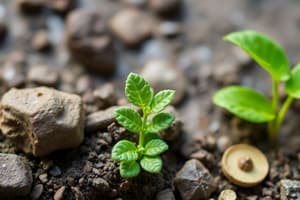Podcast
Questions and Answers
What is the primary consequence of pollution being converted to acid in the atmosphere?
What is the primary consequence of pollution being converted to acid in the atmosphere?
- It leads to acid rain falling downwind. (correct)
- It increases the nutrient levels in plants.
- It creates a toxic environment for animals.
- It enhances the growth of certain crops.
What significant change resulted from the Agricultural Revolution?
What significant change resulted from the Agricultural Revolution?
- Animals became extinct due to overhunting.
- Humans began to domesticate plants and animals. (correct)
- Human populations decreased due to scarcity of resources.
- Hunter-gatherer tribes established permanent settlements.
How did early Native American tribes impact the environment?
How did early Native American tribes impact the environment?
- They facilitated afforestation through controlled burns.
- They burned forests to drive away large animals. (correct)
- They promoted biodiversity by planting native species.
- They established national parks for wildlife protection.
What role did hunting play in the lives of early human societies?
What role did hunting play in the lives of early human societies?
What was one of the main environmental challenges faced during the transition from hunter-gatherers to agricultural societies?
What was one of the main environmental challenges faced during the transition from hunter-gatherers to agricultural societies?
What are two primary ways environmental science aims to understand and solve environmental problems?
What are two primary ways environmental science aims to understand and solve environmental problems?
Which field of study examines living organisms?
Which field of study examines living organisms?
Which of the following best describes ecology?
Which of the following best describes ecology?
What aspect of Earth science focuses on the atmosphere and climate?
What aspect of Earth science focuses on the atmosphere and climate?
In environmental decision-making, which field examines the costs and benefits related to resource use?
In environmental decision-making, which field examines the costs and benefits related to resource use?
Which study focuses on the interactions between human populations and Earth's physical features?
Which study focuses on the interactions between human populations and Earth's physical features?
What is the main concern of engineering within the context of environmental science?
What is the main concern of engineering within the context of environmental science?
Which field is primarily concerned with the study of fossils and ancient life?
Which field is primarily concerned with the study of fossils and ancient life?
What does the Seventh Generation Principle emphasize?
What does the Seventh Generation Principle emphasize?
Which components make up the environment?
Which components make up the environment?
What is the primary focus of environmental science?
What is the primary focus of environmental science?
Which of the following is NOT considered an abiotic component of the environment?
Which of the following is NOT considered an abiotic component of the environment?
How do human actions influence the environment?
How do human actions influence the environment?
Which aspect is NOT studied in environmental science?
Which aspect is NOT studied in environmental science?
What characterizes renewable resources?
What characterizes renewable resources?
What consequence is linked to changes in the physical environment?
What consequence is linked to changes in the physical environment?
What does the term 'environment' encompass?
What does the term 'environment' encompass?
Which of the following is an example of a nonrenewable resource?
Which of the following is an example of a nonrenewable resource?
What type of pollution can break down naturally over time?
What type of pollution can break down naturally over time?
Which statement about resource depletion is true?
Which statement about resource depletion is true?
Which of the following best defines biodiversity?
Which of the following best defines biodiversity?
How does pollution affect ecosystems?
How does pollution affect ecosystems?
What is the primary reason for the depletion of nonrenewable resources?
What is the primary reason for the depletion of nonrenewable resources?
Which of the following pollutants is classified as nondegradable?
Which of the following pollutants is classified as nondegradable?
What is biodiversity?
What is biodiversity?
What is mass extinction?
What is mass extinction?
How many major extinction events are known in Earth's history?
How many major extinction events are known in Earth's history?
What percentage of species disappeared during the most recent major extinction event?
What percentage of species disappeared during the most recent major extinction event?
What is the normal background extinction rate for mammals?
What is the normal background extinction rate for mammals?
Which event is believed to have caused the most recent major extinction?
Which event is believed to have caused the most recent major extinction?
Which factor has primarily contributed to the 27 mammal extinctions in Australia since 1788?
Which factor has primarily contributed to the 27 mammal extinctions in Australia since 1788?
Humans depend on other organisms for which of the following basic necessities?
Humans depend on other organisms for which of the following basic necessities?
Flashcards are hidden until you start studying
Study Notes
Introduction
- The environment encompasses all surroundings and conditions supporting living organisms, including landscapes, animals, and their interactions.
- It consists of abiotic components (lithosphere, hydrosphere, atmosphere) and biotic components (plants, animals, microorganisms).
Environmental Science
- Environmental science studies the interaction of humans with the natural environment.
- It examines how humans utilize natural resources, relate to the nonliving environment, and alter the environment.
- Key areas of study include:
- Interactions between living organisms and their nonliving surroundings
- Impact of human activities on the environment
- Interrelationships between various organisms
The Goals of Environmental Science
- To understand and solve environmental problems by examining:
- How humans use natural resources
- How human actions alter the environment
Fields of Study
- Environmental science is interdisciplinary, incorporating concepts from various fields:
- Biology: Study of living organisms
- Zoology: Study of animals
- Botany: Study of plants
- Microbiology: Study of microorganisms
- Ecology: Study of interactions between living organisms and their environment
- Earth Science: Study of Earth's nonliving systems and the planet as a whole
- Geology: Study of Earth's surface, interior processes, and history
- Paleontology: Study of fossils and ancient life
- Climatology: Study of Earth's atmosphere and climate
- Hydrology: Study of Earth's water resources
- Physics: Study of matter and energy
- Engineering: Application of matter and energy for human use
- Chemistry: Study of chemicals and their interactions
- Biochemistry: Study of the chemistry of living organisms
- Geochemistry: Study of the chemistry of materials like rocks, soil, and waste
- Social Science: Study of human populations
- Geography: Study of relationships between populations and Earth's features
- Anthropology: Study of the interactions of biological, cultural, geographical, and historical aspects of humankind
- Sociology: Study of human population dynamics and statistics
Environmental Issues and Example
- Example illustrating the interconnectedness of various fields:
- A community decides to use coal for electricity (economics).
- Coal is mined from underground (geology).
- Coal is transported (engineering).
- Burning coal releases air pollution (chemistry).
- Pollution forms acid in the atmosphere (chemistry).
- Acid rain affects plants (ecology).
- Pollution regulations are implemented (politics).
Our Environment Through Time
- Humans have impacted the environment throughout history:
- Hunting
- Agriculture
- Settlement
Hunter-Gatherers
- Humans foraged for sustenance:
- Collecting plants
- Hunting animals
- Scavenging remains
- They lived in tribes, using fire to manage prairies.
- They migrated seasonally to areas with abundant resources.
Early Environmental Problems
- Native American tribes and Aborigines utilized fire to drive animals (e.g., buffalo).
- They transported plants to new locations, introducing invasive species.
The Agricultural Revolution
- Agriculture began about 10,000 years ago, leading to the domestication of plants and animals.
- This revolution greatly impacted human populations by:
- Increasing population size
- Causing resource depletion
- Leading to pollution
- Contributing to biodiversity loss
Resource Depletion
- Natural resources are materials used by humans, classified as:
- Renewable: Can be replaced rapidly (e.g., timber, water)
- Nonrenewable: Replenished extremely slowly or not at all (e.g., coal, oil, minerals)
- Resource depletion occurs when the rate of resource use exceeds the rate of replenishment, resulting in pollution and waste.
Major Environmental Problems
- Resource Depletion:
- The large human population (8.2 billion globally, 118.2 million in the Philippines) requires significant resources.
- Nonrenewable resources are finite and subject to depletion.
- The estimated remaining coal reserves are sufficient for about 250 years at current consumption rates.
- Pollution:
- Pollution is a degradation or undesired change in air, water, or soil that affects the health of living organisms.
- Biodegradable pollution: Can be broken down naturally.
- Nondegradable pollution: Does not break down (e.g., plastics, mercury, lead).
Loss of Biodiversity
- The number of species on Earth is estimated in the tens of millions.
- Biodiversity refers to the variety of species within an ecosystem.
- Extinction is a natural process, but human actions can accelerate it.
- Loss of biodiversity is a concern due to human dependence on other organisms for food, oxygen, etc.
- Five major extinction events have occurred in Earth's history, with the most recent one (65 million years ago) causing the disappearance of 75% of species.
- Extinction normally occurs at a slow rate (background rate), but human activities are accelerating it.
Studying That Suits You
Use AI to generate personalized quizzes and flashcards to suit your learning preferences.




